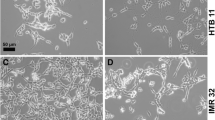Abstract
In order to determine how glycosylation changes associated with cellular differentiation may be influenced by the basal cellular sialylation potential, the effect of retinoic acid (RA)-induced differentiation was investigated in neuroblastoma cells expressing differing levels (and activities) of the α2,6(N) sialyltransferase (ST6N) enzyme. The increase in ST activity was proportional to the basal cellular sialylation potentials with the high activity clones showing the greatest increase. This was paralleled by an up-regulation of the level of overall sialoglycoprotein glycosylation level. An increase in the levels of the polysialic acid (PSA) epitope was associated with a parallel increase in the levels of the neural cell adhesion molecule (NCAM) protein backbone although there was no overall change in the PSA:NCAM ratio following RA treatment.
Similar content being viewed by others
References
Breen KC, Coughlan CM, Hayes FD, Mol Neurobiol 16, 163–220 (1998).
Cummings RD. In Glycoconjugates: composition, structure and function, edited by Allen HJ, Kisailus EC, (Marcel Dekker Inc., New York, 1992), pp. 333–60.
Harduin-Lepers A, Recchi MA, Delannoy P, Glycobiology 5, 741–58 (1995).
Georgopoulou N, Breen KC, J Neurosci Res 58, 641–51 (1999).
Coughlan CM, Seckl JR, Fox DJ, Unsworth R, Breen KC, Glycobiology 6, 15–22 (1996).
Coughlan CM, Breen KC, J Neurosci Res 51, 619–26 (1998).
Davey FD, Breen KC, Tox Appl Pharmacol 151, 16–21 (1998).
Bruses JL, Rutishauser U, J Cell Biol 140, 1177–86 (1998).
Fast DG, Jamieson JC, McCaffrey G, Biochem Biophys Acta 1202, 325–30 (1993).
Bieberich E, Freischutz B, Liour SS, Yu RK, J Neurochem 71, 972–9 (1998).
Li M, Vemulapalli R, Ullah A, Izu L, Duffey ME, Lance P, Am J Physiol 37, G599-G606 (1998).
Breen KC, Kelly PG, Regan CM, J Neurochem, 48, 1486–93 (1987).
Breen KC, Regan CM, J Neurochem 50, 712–6 (1988).
Chen C, Fenderson BA, Andrews PW, Hakomori S, Biochemistry 28, 2229–38 (1989).
Osanai T, Watanabe Y, Sanai Y, Biochem Biophys Res Comm 241, 327–33 (1997).
Lotan R, Lotan D, Amos B, Exp Cell Res 177, 284–94 (1988).
Lotan R, Lotan D, Meromsky L, Cancer Res 44, 5805–12 (1984).
Moskal JR, Lockney MW, Marvel CC, Trosko JE, Sweeley CC, Cancer Res 47, 787–90 (1987).
Sacks PG, Amos B, Lotan R, Glycoco J 13, 791–6 (1996).
Ronn LCB, Hartz BP, Bock E, Experimental Gerontology 33, 853–64 (1998).
Cervello M, Damelio L, Tesoro V, Rougon G, Matranga V, Eur J Cell Biol 73, 270–5 (1997).
Rebahn M, Vacun G, Bayreuther K, Rosner H, NeuroReport 5, 941–4 (1994).
Husmann M, Gorgen I, Weisgerber C, Bitter-Suermann D, Dev Biol 136, 194–200 (1989).
Schubert D, Heinemann S, Carlisle W, Tarikas H, Kimes B, Partick J, Steinbach JH, Culp W, Brandt BL, Nature 249, 224–7 (1974).
Breen KC, Regan CM, J Neurochem 47, 1176–80 (1986).
Lowry GH, Rosenbrough NL, Farr AL, Randall RJ, J Biol Chem 193, 265–75 (1951).
Reboul P, George P, Miquel D, Louisot P, Broquet P, Glyco J 13, 69–79 (1996).
Breen KC, Potratz A, Georgopoulou N, Sandhoff K, Glyco J 15, 199–202 (1998).
Close BE, Colley KJ, J Biol Chem 273, 34586–93 (1998).
Muhlenhoff M, Eckhardt M, Bethe A, Frosch M, GerardySchahn R, EMBO J 15, 6943–50 (1996).
Ong E, Nakayama J, Angata K, Reyes L, Katsuyama T, Arai Y, Fukuda M, Glycobiology 8, 415–24 (1998).
Seidenfaden R, Hildebrandt H, J Neurobiol 46, 11–28 (2001).
Georgopoulou N, Breen KC, Glyco J 16, 649–57 (2000).
Author information
Authors and Affiliations
Rights and permissions
About this article
Cite this article
Georgopoulou, N., Breen, K.C. Retinoic acid induction of sialyltransferase activity in neuroblastoma cells of differing sialylation potentials. Glycoconj J 17, 781–786 (2000). https://doi.org/10.1023/A:1010936725694
Issue Date:
DOI: https://doi.org/10.1023/A:1010936725694




